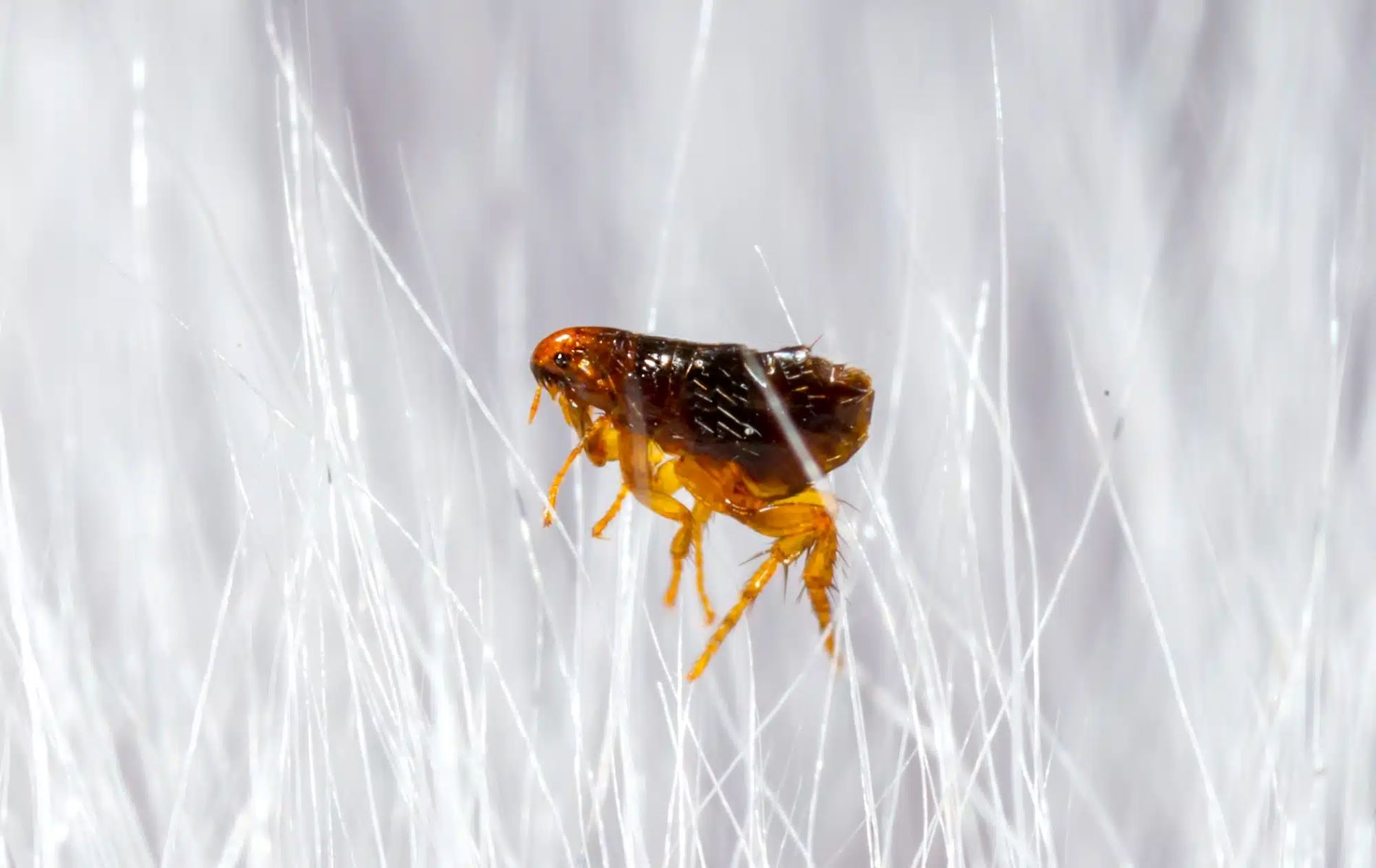Home>Science>The Surprising Truth About Fleas’ Jumping Abilities


Science
The Surprising Truth About Fleas’ Jumping Abilities
Published: February 12, 2024
Discover the surprising truth about fleas' jumping abilities and the science behind their incredible agility. Learn more about the fascinating world of flea behavior.
(Many of the links in this article redirect to a specific reviewed product. Your purchase of these products through affiliate links helps to generate commission for Regretless.com, at no extra cost. Learn more)
Table of Contents
Introduction
Fleas are often associated with pesky irritations and relentless itching, but there's more to these tiny creatures than meets the eye. These minuscule insects, known for their incredible jumping abilities, have long piqued the curiosity of scientists and entomologists alike. While their small size may lead one to underestimate their capabilities, fleas are equipped with remarkable anatomical features that enable them to perform astounding feats of agility.
In this article, we'll delve into the fascinating world of fleas, exploring their anatomy and shedding light on the science behind their exceptional jumping prowess. By understanding the mechanics of flea jumps and comparing them to other jumping animals, we can gain a deeper appreciation for the natural world and the remarkable adaptations that have evolved over time. Furthermore, we'll examine the implications of fleas' jumping abilities for pest control, offering insights into how this knowledge can be leveraged to address issues related to flea infestations.
Prepare to be astonished as we uncover the surprising truth about fleas' jumping abilities and embark on a journey through the captivating realm of entomology. Let's unravel the mysteries of these extraordinary creatures and gain a newfound admiration for the intricate mechanisms that govern their movements.
Flea Anatomy
Fleas, despite their diminutive size, boast a complex and highly specialized anatomy that equips them with the remarkable ability to execute prodigious jumps. These tiny insects, typically measuring between 1 to 4 millimeters in length, possess a body structure that is finely tuned for exceptional agility and mobility.
Exoskeleton
At the core of a flea's anatomy lies its exoskeleton, a rigid outer covering that provides structural support and protection. This exoskeleton, composed of a tough substance called chitin, serves as a sturdy framework for the flea's body, allowing it to withstand the forces generated during its rapid movements. The exoskeleton also plays a crucial role in facilitating the flea's impressive jumping capabilities by providing a robust anchor for its powerful leg muscles.
Leg Structure
One of the most striking features of a flea's anatomy is its extraordinary hind legs, which are specially adapted for leaping. These elongated and muscular appendages are designed to store and release energy efficiently, enabling fleas to catapult themselves to astonishing heights and distances. The unique structure of their legs, coupled with the inherent elasticity of their tendons, allows fleas to generate propulsive force that far exceeds what one might expect from such tiny creatures.
Musculature
Beneath the surface of a flea's exoskeleton lies a complex network of muscles that are intricately interconnected to facilitate rapid and coordinated movements. These muscles, particularly prominent in the flea's hind legs, enable it to execute explosive jumps with remarkable precision and force. The synchronized action of these muscles, combined with the elastic properties of the flea's leg tendons, culminates in the swift and dynamic propulsion that characterizes flea jumps.
Adaptations for Blood Feeding
In addition to their remarkable jumping abilities, fleas possess specialized mouthparts adapted for piercing the skin of their hosts and extracting blood. These mouthparts, known as stylets, are designed to penetrate the skin with minimal resistance, allowing fleas to feed on the blood of their hosts with remarkable efficiency. The adaptation of their mouthparts underscores the intricate evolutionary adaptations that have shaped the anatomy of fleas to suit their parasitic lifestyle.
Sensory Organs
Fleas are equipped with sensory organs that enable them to navigate their environment and locate potential hosts. Their antennae, equipped with sensory hairs, allow them to detect chemical cues and perceive changes in their surroundings. These sensory adaptations play a crucial role in guiding fleas toward suitable hosts and facilitating their survival in diverse environments.
In summary, the anatomy of fleas is a testament to the remarkable evolutionary adaptations that have endowed these tiny insects with extraordinary jumping abilities and specialized features for blood feeding. By unraveling the intricacies of flea anatomy, we gain valuable insights into the sophisticated mechanisms that govern their movements and behaviors.
Jumping Abilities of Fleas
Fleas are renowned for their exceptional jumping prowess, a remarkable trait that sets them apart in the insect world. Despite their minuscule size, these tiny creatures are capable of executing astonishing vertical leaps that can propel them to heights of up to 150 times their body length. This extraordinary feat of agility is made possible by the intricate interplay of biomechanical factors and specialized anatomical adaptations that empower fleas to achieve remarkable aerial maneuvers.
Biomechanics of Flea Jumps
The mechanics of flea jumps are a testament to the awe-inspiring efficiency of nature's design. When a flea prepares to jump, it contracts its powerful leg muscles, storing potential energy within the resilient structures of its legs. As the flea's leg muscles rapidly extend, the accumulated energy is released, propelling the flea into the air with explosive force. The coordinated action of its leg muscles and the elasticity of its leg tendons allows the flea to achieve rapid acceleration and remarkable heights in a fraction of a second.
Read more: The Surprising Truth About Sweating In Suits
Extraordinary Leaping Distances
The agility of fleas is further underscored by the incredible distances they can cover in a single leap. These diminutive insects are capable of leaping horizontally distances that are approximately 200 times their body length, showcasing their astonishing mobility and agility. Such prodigious leaps enable fleas to navigate their environment with unparalleled speed and efficiency, evading potential threats and swiftly locating hosts for blood feeding.
Anatomical Adaptations for Jumping
The remarkable jumping abilities of fleas are underpinned by their specialized anatomical adaptations, particularly in their hind legs. The elongated and muscular structure of their hind legs, coupled with the inherent elasticity of their leg tendons, enables fleas to generate and release energy with exceptional efficiency. Moreover, the rigid exoskeleton of fleas provides a robust anchor for their powerful leg muscles, allowing them to withstand the forces generated during their rapid jumps.
Implications for Pest Control
Understanding the biomechanics and extraordinary jumping abilities of fleas holds significant implications for pest control strategies. By gaining insights into the mechanics of flea jumps, researchers and pest control experts can develop innovative approaches to mitigate flea infestations and minimize the impact of these pests on human and animal health. Leveraging knowledge of flea behavior and mobility, such as their remarkable jumping prowess, can inform the development of targeted and effective pest management solutions.
In summary, the jumping abilities of fleas stand as a testament to the remarkable adaptations and biomechanical marvels that are woven into the fabric of the natural world. By unraveling the intricacies of flea jumps, we gain a deeper appreciation for the awe-inspiring capabilities of these tiny insects and the intricate mechanisms that govern their agile movements.
Comparison to Other Jumping Animals
When it comes to the realm of jumping prowess, fleas stand out as extraordinary performers, showcasing unparalleled agility and remarkable feats of aerial mobility. However, the world of jumping animals encompasses a diverse array of species, each endowed with unique adaptations and specialized capabilities for executing prodigious leaps. By comparing the jumping abilities of fleas to those of other remarkable jumpers in the animal kingdom, we can gain valuable insights into the fascinating adaptations that have evolved across different species.
Froghoppers
Froghoppers, also known as spittlebugs, are renowned for their exceptional jumping abilities, which enable them to execute impressive leaps that far exceed the capabilities of fleas in terms of distance. These tiny insects, despite their diminutive size, are capable of jumping to heights that are approximately 100 times their body length, showcasing remarkable agility and explosive propulsion. The biomechanics of froghopper jumps involve the rapid and coordinated action of their leg muscles, coupled with the release of stored energy, enabling them to achieve astonishing aerial maneuvers.
Grasshoppers
Grasshoppers are iconic symbols of jumping prowess in the insect world, renowned for their remarkable ability to cover impressive distances in a single leap. These adept jumpers can propel themselves horizontally to distances that are several times their body length, showcasing extraordinary mobility and agility. The powerful and muscular hind legs of grasshoppers, coupled with their specialized leg structure, enable them to generate propulsive force and execute rapid jumps with remarkable precision.
Kangaroos
In the realm of vertebrates, kangaroos reign supreme as masters of jumping, possessing the ability to execute powerful and sustained leaps known as "pentapedal locomotion." These iconic marsupials are capable of covering vast distances with each bound, showcasing remarkable endurance and agility. The biomechanics of kangaroo jumps involve the coordinated action of their hind legs, coupled with the elastic properties of their tendons, enabling them to achieve remarkable propulsion and energy-efficient locomotion.
Fleas
In comparison to other jumping animals, fleas exhibit extraordinary vertical jumping abilities that far surpass the capabilities of many larger creatures. Despite their diminutive size, fleas can leap to heights that are approximately 150 times their body length, showcasing remarkable agility and explosive propulsion. The specialized adaptations of their hind legs, coupled with the biomechanical efficiency of their jumps, enable fleas to achieve astonishing aerial maneuvers with remarkable precision.
In summary, the comparison of fleas' jumping abilities to those of other remarkable jumpers in the animal kingdom offers a captivating glimpse into the diverse adaptations and specialized capabilities that have evolved across different species. Each of these extraordinary jumpers, from froghoppers and grasshoppers to kangaroos and fleas, embodies the remarkable ingenuity of nature's design, showcasing unparalleled agility and mobility in the pursuit of survival and locomotion.
Read more: The Surprising Truth About Medusa’s Origins
Implications for Pest Control
Understanding the biomechanics and extraordinary jumping abilities of fleas holds significant implications for pest control strategies. By gaining insights into the mechanics of flea jumps, researchers and pest control experts can develop innovative approaches to mitigate flea infestations and minimize the impact of these pests on human and animal health. Leveraging knowledge of flea behavior and mobility, such as their remarkable jumping prowess, can inform the development of targeted and effective pest management solutions.
The exceptional agility and mobility displayed by fleas, particularly in their vertical and horizontal leaps, underscore the challenges posed by these tiny yet formidable pests. Fleas' ability to swiftly navigate their environment and reach hosts for blood feeding highlights the need for proactive and strategic pest control measures. By recognizing the remarkable aerial maneuvers of fleas, pest control professionals can tailor interventions to target specific stages of the flea life cycle, thereby disrupting their reproductive capabilities and curtailing infestations.
Moreover, the knowledge of flea jumping abilities can inform the design of physical barriers and traps that capitalize on the insects' propensity for leaping. By incorporating this understanding into the development of pest control devices, such as flea traps and barriers, researchers can enhance the efficacy of these interventions, thereby aiding in the containment and eradication of flea populations.
Additionally, insights into flea biomechanics can inform the refinement of insecticidal formulations and delivery methods, optimizing the efficacy of chemical interventions while minimizing environmental impact. By aligning pest control strategies with the remarkable capabilities of fleas, researchers can develop targeted and environmentally responsible approaches that address infestations with precision and efficiency.
Furthermore, educating pet owners and the general public about the implications of flea jumping abilities can foster proactive measures to prevent infestations and minimize the risk of flea-borne diseases. By raising awareness of the agility and mobility of fleas, individuals can implement preventive measures, such as regular pet grooming and environmental sanitation, to mitigate the risk of infestations and safeguard the well-being of both pets and humans.
In summary, the understanding of fleas' jumping abilities has far-reaching implications for the development of innovative pest control strategies. By leveraging insights into flea biomechanics, researchers and pest control experts can refine interventions, educate the public, and ultimately mitigate the impact of flea infestations on human and animal health.
Conclusion
In conclusion, the remarkable jumping abilities of fleas stand as a testament to the awe-inspiring adaptations and biomechanical marvels that are intricately woven into the fabric of the natural world. These tiny insects, equipped with specialized anatomical features and remarkable agility, defy expectations and showcase the extraordinary capabilities that have evolved over millennia of natural selection. By unraveling the intricacies of flea jumps and comparing them to the feats of other remarkable jumpers in the animal kingdom, we gain a deeper appreciation for the diverse adaptations and specialized capabilities that have emerged across different species.
The biomechanics of flea jumps, underpinned by the coordinated action of their powerful leg muscles and the inherent elasticity of their leg tendons, enable these diminutive insects to achieve astonishing aerial maneuvers with remarkable precision and force. Furthermore, the implications of flea jumping abilities for pest control strategies offer valuable insights into the development of targeted and effective interventions to address flea infestations and minimize their impact on human and animal health.
As we reflect on the surprising truth about fleas' jumping abilities, we are reminded of the intricate and wondrous complexities that define the natural world. From the remarkable adaptations of fleas' anatomy to the implications for pest control, the study of these tiny creatures unveils a captivating tapestry of evolutionary marvels and scientific insights. By embracing a deeper understanding of fleas and their remarkable jumping prowess, we embark on a journey through the captivating realm of entomology, marveling at the intricate mechanisms that govern the agile movements of these extraordinary insects.
In the grand tapestry of life, fleas stand as testament to the remarkable ingenuity of nature's design, showcasing unparalleled agility and mobility in the pursuit of survival and locomotion. The surprising truth about fleas' jumping abilities serves as a reminder of the remarkable adaptations and biomechanical marvels that underpin the intricate dance of life on our planet. As we continue to unravel the mysteries of the natural world, the remarkable capabilities of fleas inspire us to marvel at the wonders of evolution and the extraordinary adaptations that have shaped the diversity of life on Earth.











